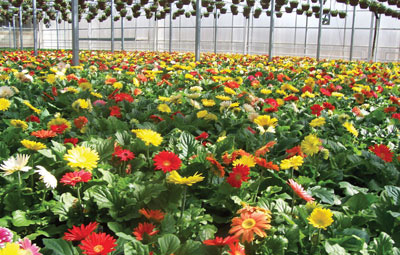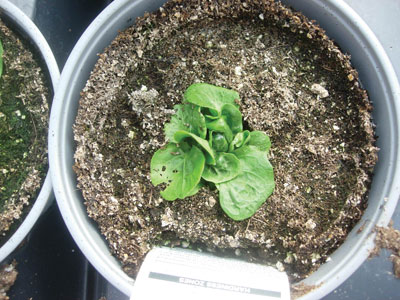
Few plants catch the eye of the consumer more than gerbera daisies.
Throughout the past decade these plants have become a hot impulse buy at
retail.
Few plants catch the eye of the consumer more than gerbera daisies. Throughout the past decade these plants have become a hot impulse buy at retail.
 |
|
| A 6” gerbera crop. PHOTOS COURTESY HARVEY LANG/SYNGENTA FLOWERS Advertisement
|
Gerberas have a wide colour range, from soft pinks and whites to fiery reds, oranges and yellows. Several colourful flower forms continue to hit the market every year, from semi-double types to those with attractive dark or green centres.
Gerberas are popular in the spring to summer season, but can also be grown for Valentine’s Day, Labour Day and other off-season holidays. They are also grown as cut flowers and are commonly used in floral arrangements. Consumers can use them either as indoor potted plants or in the outdoor landscape in ground beds and containers.
While consumers love gerbera daisies, crop production at the greenhouse stage requires keen attention to detail to ensure the highest quality product. Important protocols need to be followed from early plug production all the way through finishing. Here are some key tips growers can use to be successful with gerbera.
PLUG CULTURE
■ Light: Gerbera requires light during germination, so the seed does not need to be covered. However, some growers use a light cover of coarse vermiculite to maintain a higher humidity around the seed. When using a vermiculite cover, apply a very light amount so that the seed is still visible after the trays have been irrigated.
 |
|
| Dr. Harvey Lang of Syngenta Flowers
|
Growers using germination chambers should have a light source (incandescent is fine) during the early germination process. Optimum daylength during germination is 16 hours. If possible, use supplemental lights during low light periods from stage three on (plug bulking). Ideal light intensities during this time range from 3500 to 4500 f.c. (12-16 mols/day).
Temperature: The optimal temperature for germination (first three to four days from seeding) is between 73-76 F (23-24 C). There is a significant drop in germination rate at lower temperatures. After radical emergence and cotyledons are visible, temperatures can be dropped to 70-72 F (21-22 C) and eventually down to 68-70 F (20-21 C) as new leaves begin to form and the plug is bulked.
Plant growth regulators (PGRs): There are several different lines of gerbera on the commercial market. While some have relatively compact growth habits and require little, if any, growth regulation, vigorous types may require one or more applications of B-Nine® at 1250-1500 ppm to keep them compact. The key is to know the varieties and apply the PGR in a timely manner.
Humidity and moisture: Keep humidity above 95 per cent for the first three to four days or until the seed coat is shed. Saturate (5) media moisture levels during this time. Some growers use a plastic cover over the seed trays to maintain very high humidity. If using covers, monitor the media and avoid temperatures above 77 F (25 C).
After germination and during the cotyledon expansion phase, reduce moisture levels and alternate irrigations between saturated (5) and moist (3). Drop humidity to 70 to 75 per cent during this time.
Once new leaves begin to form (after about Day 8), it is critical to reduce humidity and moisture levels. Reduce humidity to about 40 to 60 per cent, while alternating media irrigation cycles between wet (4) and medium (2). Dry the media surface to a medium brown colour before beginning irrigation again. Good air circulation is very important during this time.
One of the biggest mistakes made during plug production is over-saturation of the media from Week 2 to Week 5. Over-saturated plants will produce clubby, malformed leaves; growing tips will be lost; rooting will be poor; and the plants will be stunted.
Try to irrigate the plugs in the morning and avoid water sitting on the growing tips as plants go into the evening period. Also make sure that the wet media is not covering the young growing tips. If plugs are suffering from over-saturated media, drying down the plugs can help overcome the leaf deformities, but many times the young plant does not recuperate and the seedling is lost.
Media and fertilization: Use a porous, well-drained plug mix with an EC (electrical conductivity) between 1.0-1.2 and a pH of 5.4-5.8. Avoid heavy plug mixes that stay wet for long periods of time.
Begin fertilization after five to six days and after cotyledons are formed. Some fertilizers that work well are a 14-4-14 or 17-5-17 at 50 ppm N. Softer feeds, such as a 20-10-20, can also be used periodically if the light levels are higher (i.e., in late spring and summer).
After 14 days and when the seedlings are becoming established, increase the fertilizer to 100-150 ppm N. The main consideration early on is to make sure that the plants receive enough feed and that the pH remains at or below 5.8. Higher pH levels can cause leaf yellowing and iron/manganese deficiencies, especially if the media is staying too wet.
Plug crop time: Most gerbera plugs are germinated in 128 or 144 trays, although some growers have success with larger 84 and 72 trays. Most plugs are ready to transplant when they reach about five true leaves. Plug times generally are:
- 144 – five to six weeks.
- 128 – six to seven weeks.
- 84, 72 – seven to eight weeks.
The larger the plug size, the more critical it is to have good moisture control. Some growers have good success and very uniform crops by doing a double-transplant on the seedlings. That is, they might sow into a 144 or 128, then transplant these seedlings after four to five weeks over to a 72 or even 50 plug tray. In this way, they can segregate weaker seedlings from stronger ones and provide a more uniform crop before transplant into the final container.
If a grower is struggling with gerbera plug production and can’t get more than 85 per cent of usable seedlings, then it might be time to consider buying plugs. Gerbera seed is expensive. What’s more, there are many specialty plug growers who do a great job producing high quality gerbera plugs.
FINISHING
■ Transplanting: Transplant young plants on time so that they do not become root-bound in the plug trays. When transplanting gerbera, it is critical that they not be planted too deep. If the media covers the crown of the plant, the plants will flower unevenly (sometimes not even forming flowers) and can become stunted and diseased.
 |
|
| Overwatering at the plug and young plant stage can cause leaf cupping and malformation.
|
Temperature and light: Temperature can be maintained at 70-72 F (21-22 C) for about one to two weeks after transplant to help get the young plants established. Thereafter, run average daily temperature (ADT) ideally around 67-68 F (19-20 C). Flowering can be delayed if temperatures drop below 60 F (16 C).
Supplemental lighting can be very beneficial, especially during the winter months. Gerbera are facultative short-day plants, but will flower under relatively long daylengths. Plants grown for summer sales are generally larger, leafier, have larger flowers/flower stalks, and will take longer to bloom than those grown in early spring. An ideal daylength for gerberas grown in most container sizes is between 12 and 13 hours, although longer daylengths (i.e., 14 hours) can be used in the first two weeks after transplant to help establish the plants.
Fertilization: It is important to maintain a constant supply of fertilizer to keep plants green and healthy. Begin feeding at 200 ppm N using Cal-Mag types (15-5-15 or 17-5-15) and adjust as necessary to maintain proper EC levels. Keep media EC levels between 1.8-2.0 mS/cm. Under high light and warm temperature conditions, a 20-10-20 can be used to supplement the Cal-Mag types.
Monitor pH regularly and maintain between 5.4 and 5.8. As with plugs, higher pH levels can lead to iron and manganese deficiencies. A drench of iron-chelate (Sprint® 138 or 330) at 2-4 oz./100 gal is recommended for correcting iron-deficient plants. Rinse foliage with tap water after applying the chelate to prevent possible leaf burn. If growers decide not to use fertilizers with boosted Mg levels, then a one-time drench with MgSO4 (Epsom salts) at 8 oz./100 gal is recommended.
Plant growth regulators (PGRs): As discussed earlier, knowing the relative vigour of the varieties being grown will help in implementing PGR strategies. B-Nine sprays of 1500-2500 ppm are commonly used to control growth, especially when plants are grown in small pots or under tight spacing. Avoid any B-Nine sprays after buds reach about 1 cm since this can cause small flowers and short flower stems. A temperature drop (dip) of 5-8 F (2-4 C) can also be used in the early mornings to help tone plants and control growth if necessary.
Moisture: As with plugs, moisture management is very important after transplant. It is crucial to have a well-drained media for gerbera production to avoid over-saturation, especially under cool, cloudy conditions.
Avoid overwatering to make sure plants get adequate dry-down cycles (alternate wet (4) to medium (2) moisture levels). Group smaller plants separately from larger plants and irrigate accordingly. It is best to err on the dry side with gerberas versus keeping plants consistently wet.
Insects and diseases: Growers need to regularly scout for insects and diseases on gerbera. Fungal root rot and Botrytis are common diseases for plants that are overwatered and grown under very high humidity. Powdery mildew can spread quickly when there are cool nights and large temperature swings within the greenhouse.
On the insect side, growers should keep an eye out for thrips, spider mites, cyclamen mites and leaf miners. Thrips can be especially damaging to flowers, so inspect plants closely as buds begin to form.
Crop timing: Gerbera can be grown in a wide range of containers and baskets and will vary somewhat in their bloom time depending on the product line and variety. Under most growing conditions, plants generally take about three weeks or so once pea-size buds are visible in the crown. Crop times after transplant (from a 128 plug) are generally: 4-inch, quart (1 ppp) – 8 to 9 weeks (summer), 10 to 11 weeks (winter); 6-inch (1 ppp) – 9 to 10 weeks (summer), 11 to 12 weeks (winter); and 10-inch basket (3-4 ppp) – 9 to 10 weeks (summer), 11 to 12 weeks (winter).
Gerbera continues to delight consumers around the world. By following these tips growers can fine-tune their production and provide great-looking plants for the gardening public.
©2012 Syngenta Flowers, Inc., P.O. Box 1349, Gilroy, California 95021.
Important: Always read and follow label instructions before buying or using Syngenta products. The instructions contain important conditions of sale, including limitations of warranty and remedy. B-NINE® is a trademark of Uniroyal Chemical Company, Inc. SPRINT®is a trademark of Becker-Underwood, Inc.
| Industry veteran As technical services rep with Syngenta Flowers, Lang works closely with brokers and growers providing cultural advice for geraniums, poinsettias and vegetative products. He develops technical information and documentation on Syngenta Flowers products for both the greenhouse industry and consumers. Lang received his B.S., M.S, and PhD from Kansas State University, Texas A&M University, and Penn State University, respectively. He worked for several years as a state extension specialist at Iowa State University and as an educator/researcher at Texas A&M University. |
Dr. Harvey Lang is technical services rep with Syngenta Flowers. He can be reached at harvey.lang@syngenta.com.
Print this page